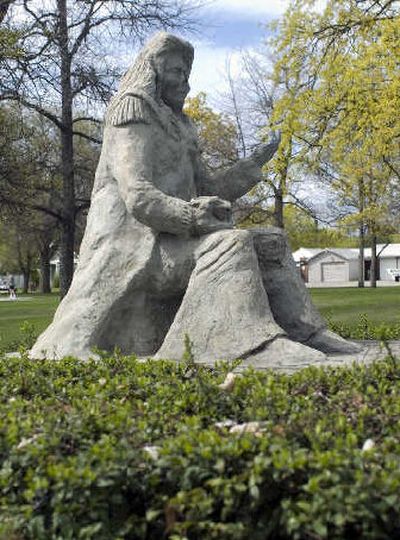Future of Garry sculpture in doubt

Vandals and time have taken their toll on a 28-year-old sculpture of Chief Garry in east Spokane.
He lost his nose a few months ago.
His fingers on his raised arm have been broken and repaired repeatedly. Vandals apparently think it’s funny to leave just his middle finger pointed upward.
Now, folks in the neighborhood are wondering if Chief Garry’s time has passed.
The 1979 statue sits along Mission Avenue as a focal point in Chief Garry Park. The sculpture was built in place with concrete and reinforcing steel bar by artist Michael Paul, a Native American who was hired as part of a federal community development project.
Leaders in the neighborhood believe Chief Garry deserves better, saying that maybe it’s time to replace the statue with a new one.
“It’s so far gone, it probably can’t be saved,” said Kathy Scacco, chairwoman of the Chief Garry Park Neighborhood Council.
“I think it’s sad that a historical figure like that has gone to decay so much,” Scacco said. “The intention when it was put in there was to honor him.”
Chief Garry, born in about 1811, was a chief of what came to be known as the middle Spokane tribe. Revered as a teacher and peacemaker, he died a pauper in 1892 after his farm had been taken from him.
Late in his life, he lived in a tepee in the Indian Canyon area of west Spokane.
Replacing the statue would be expensive.
Karen Mobley, Spokane city arts director, said a bronze statue could cost as much as $150,000. Cast bronze is costly, but it is sufficiently durable to withstand vandalism.
The existing statue cannot be moved since it was built in place. Taking it out of the park essentially would destroy it, Mobley said.
“It’s not like a knickknack you can pick up and move,” she said.
Mobley has offered to give the neighborhood a sculpture by David Govedare that recently was donated to the city by the Northwest Museum of Arts and Culture.
Scacco said she has been in contact with the Spokane Tribe to find out what it wants to do about the damaged statue.
She and other members of the neighborhood are hoping to raise money for a replacement.
“It’s the signature of the neighborhood,” she said.
The statue, she said, “should be an honor that befits who he was.”
Members of the neighborhood council voted in March in favor of removal of the statue, Mobley said. But in a meeting last week, council members backed away from that position in favor of seeking a replacement, Scacco said.
The city Arts Commission also has voted in favor of removing the statue, Mobley said, but she said she is not going to rush any decision about what to do with the artwork.
Concrete statues typically last only about 30 years, she said.
“It’s more responsible to destroy something that no longer carries the artist’s vision or artist’s integrity,” Mobley said.